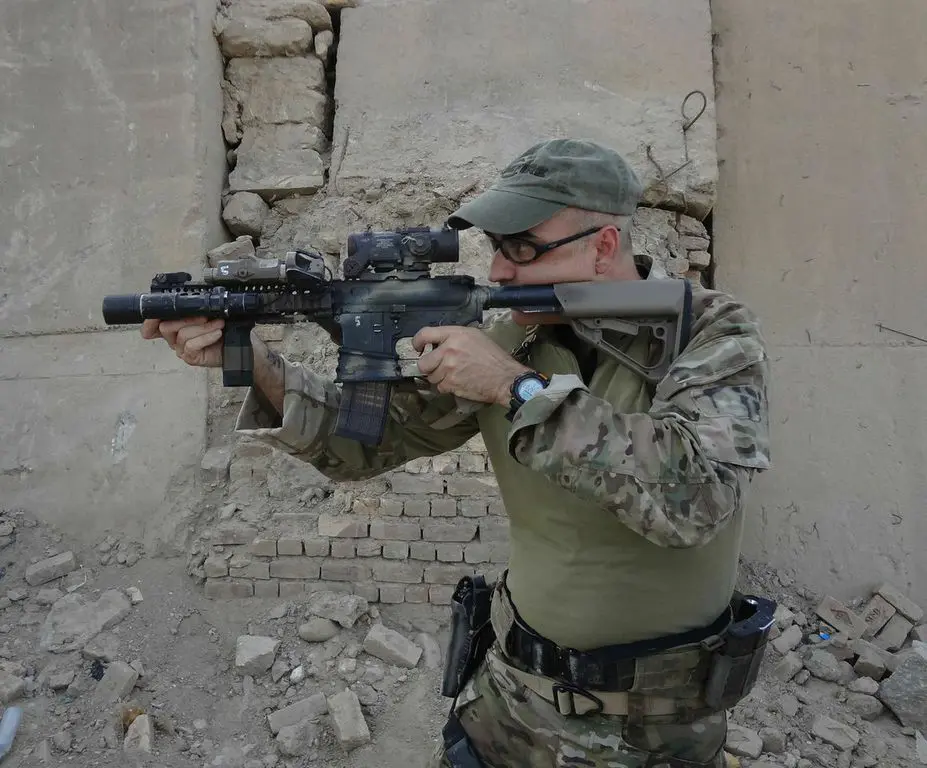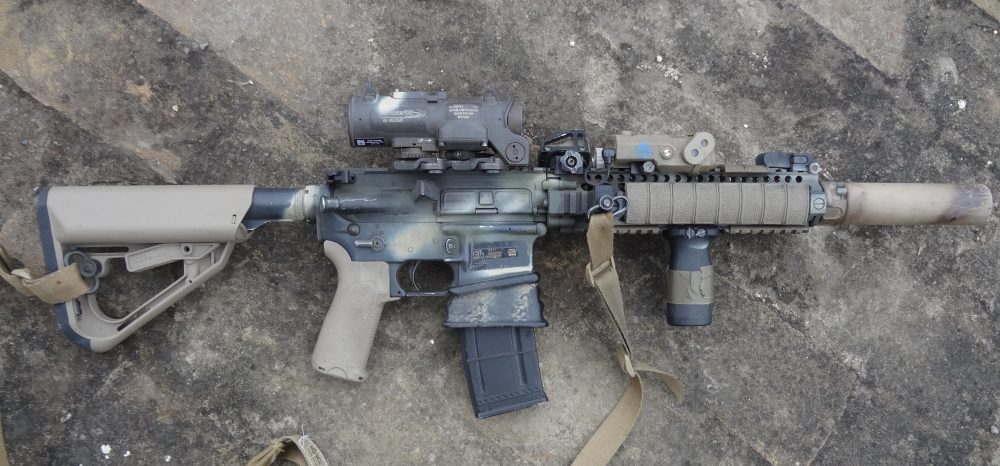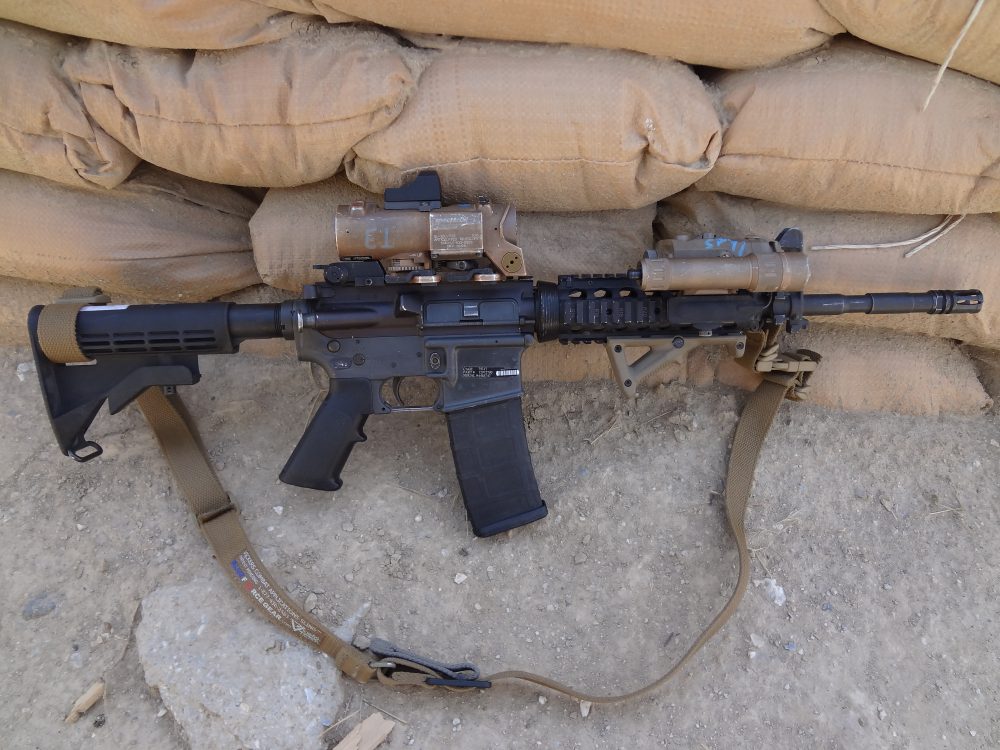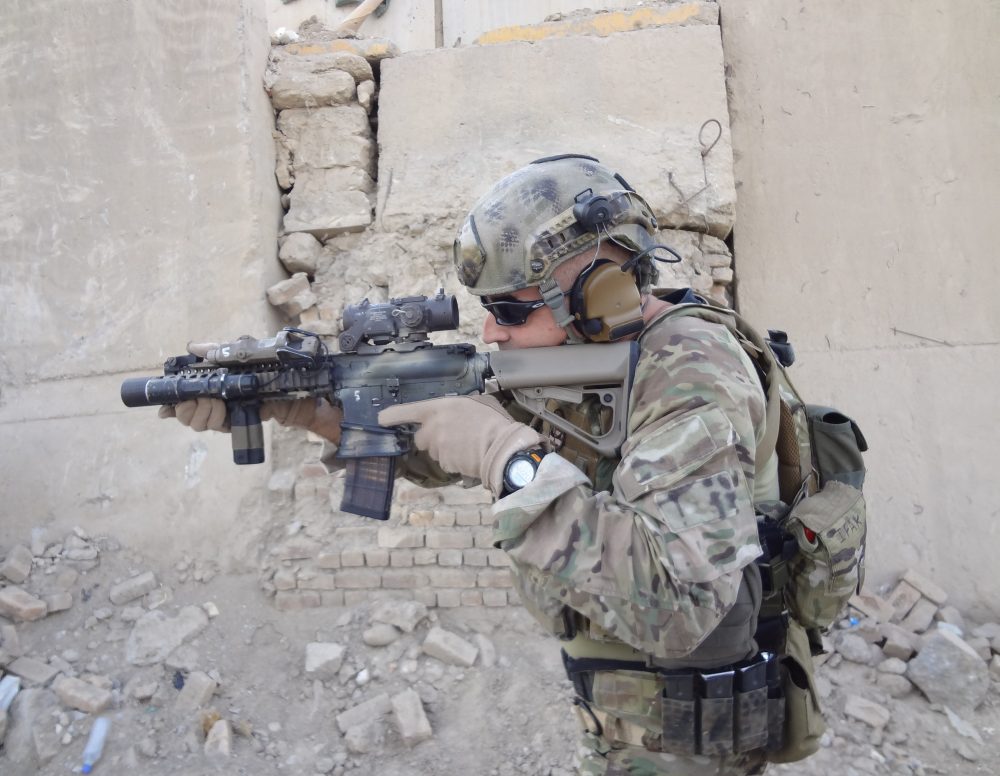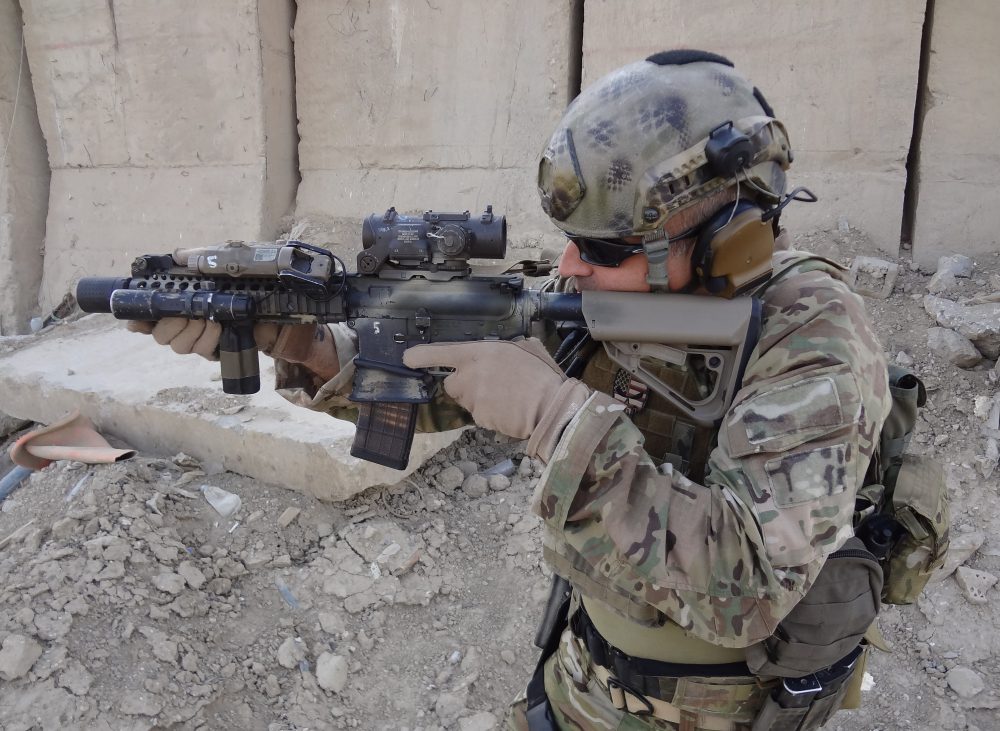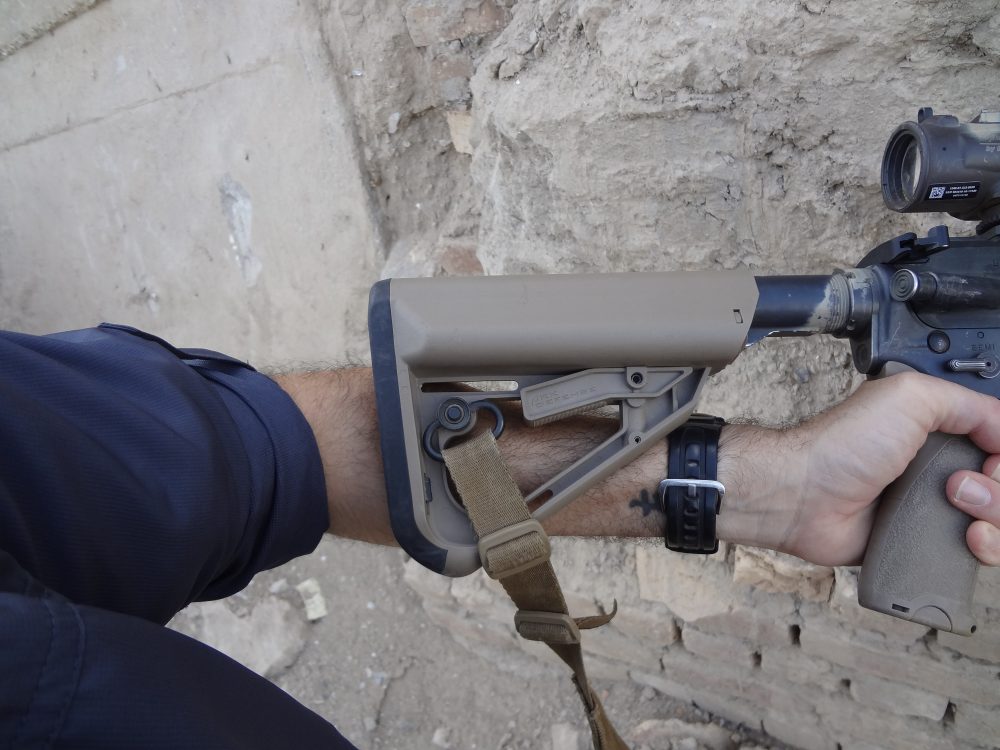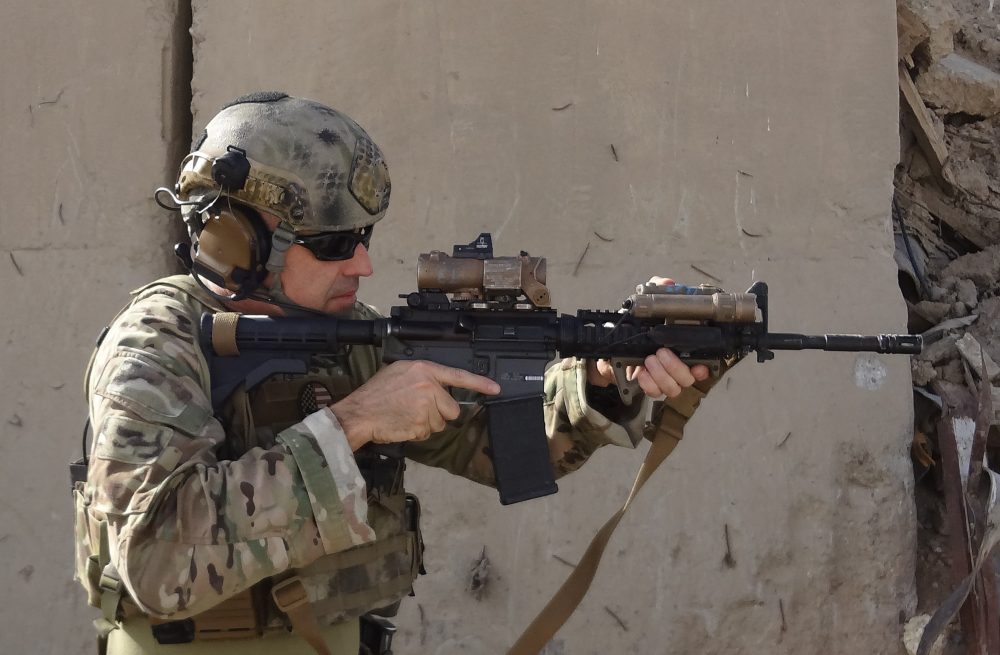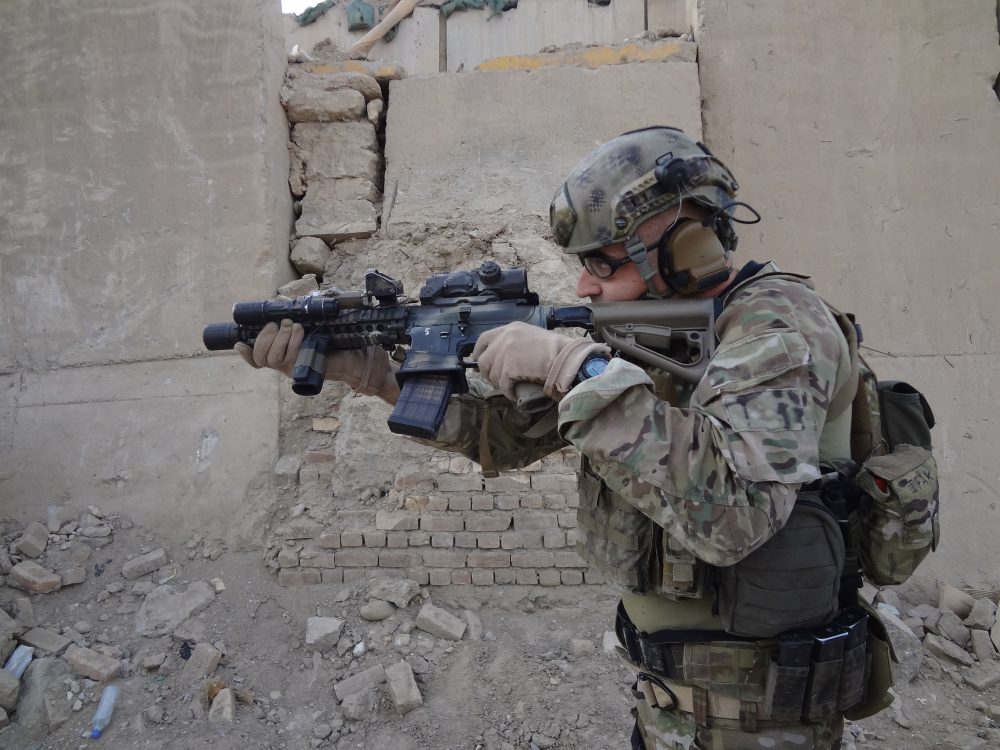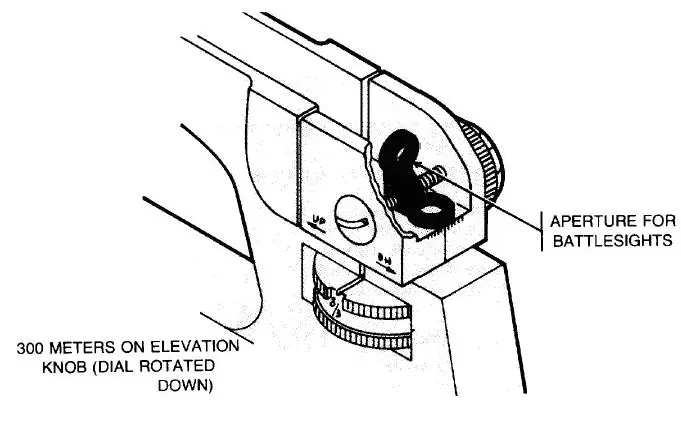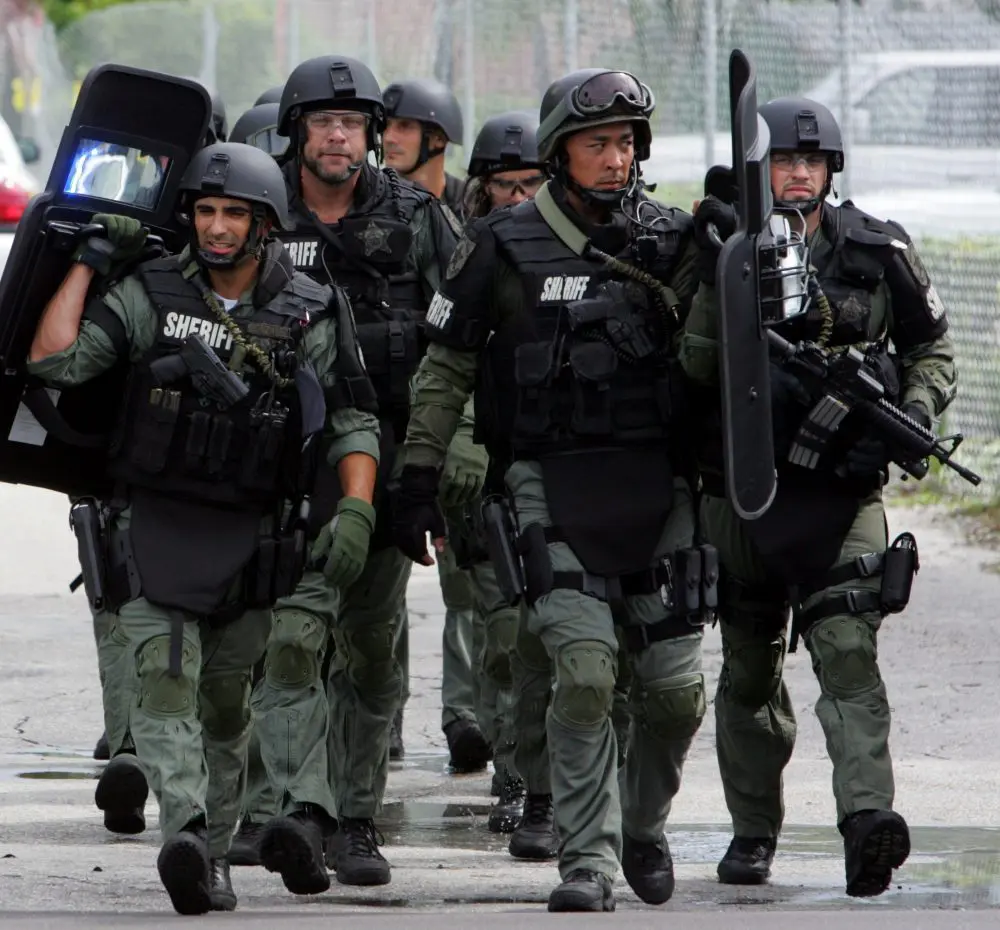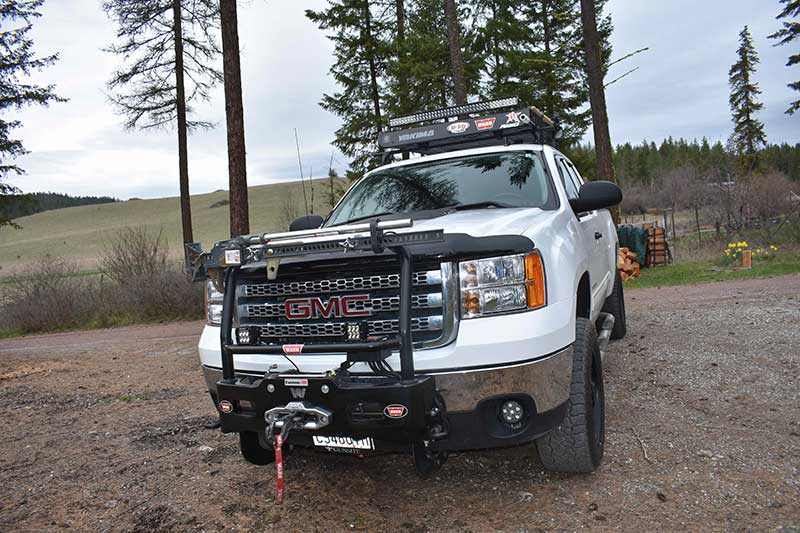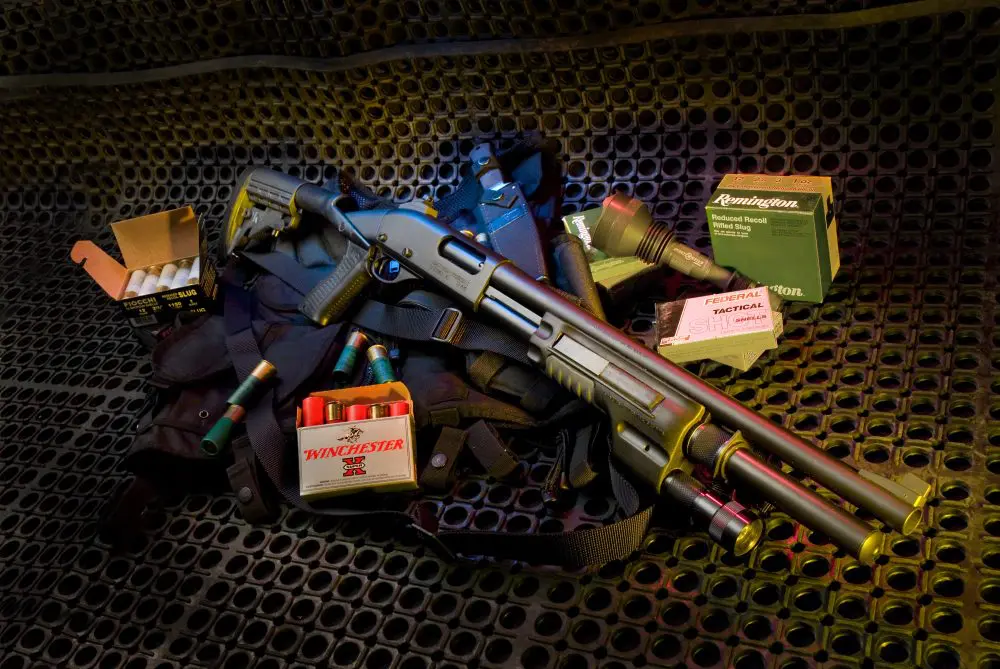One of the many reasons the AR-15 is so popular is its modularity. At first, there were basically two choices in ARs: a full rifle and a carbine version. But since the mid-1990s, the AR has been transforming. Prior to that, accessories consisted of a few simple lights that attached via barrel clamp, and some scopes and red dots that mounted via the carrying handle.
Today, tactical shooters have an almost unlimited number of options and accessories to choose from. The biggest issue I see among shooters now is the poor placement of the accessories. Everything from buttstocks not sized correctly to optics not placed for the best eye relief, to lights and lasers positioned where they obstruct proper support-hand grip.
Where you mount your parts and accessories is just as important as what accessories you choose. Your carbine needs to be set up and sized to fit you, not set up to be “tacticool.”
Author’s MK18 with Elcan Spectre 1-4, EOTech mini red dot in 45-degree offset mount, aftermarket stock and pistol grip. Aside from being a shorty, this tactical carbine is set up the same as many 3-gun Open Division rifles—anything to give the shooter the advantage on the battlefield.
Table of Contents
KISS OR ALL OUT?
Before I address where and how to set up your rifle, let me touch on what is needed for a tactical rifle. Generally there are two schools of thought: Keep It Simple Stupid (KISS), and going all out.
KISS set-ups feature bare minimums: a light, maybe one optic, and iron sights. Some KISS advocates won’t even consider using an optic for fear of it failing or using ambi-controls because “If it was not put on there in the first place, it’s not needed and overcomplicates your rifle.”
Personally I think these people are limiting themselves. Using the U.S. Army as an example, in 1997-98, they realized that issuing optics like red dots and ACOGs greatly enhanced the average soldier’s capability of hitting targets, especially at distance.
Except for some added shooting positions, the standard Army qualification test has not changed in the last 20+ years. To qualify as Expert, you must shoot 37 or better out of 40 targets going out to 300 meters. I hate to say this, but even in SOF, some soldiers have trouble getting a good score with iron sights. Throw on an optic, even just a red dot, and shooting the standard Army qual is almost too easy.
Using irons, your front sight is about 16 MOA wide. This means that at a 300-meter target, your front sight post appears as 48 inches wide. Being that wide, you cannot really place your front sight on an exact spot—you just have to hold center and hope for the best.
Using a red dot with an average 2 MOA dot, it appears as a six-inch circle at the same 300-meter target. At that size, you can easily distinguish exactly where your dot is on the target and correctly hold off for range.
Because of this, I fall into the category of going all out for a tactical set-up. If it enhances my ability to engage a target, I say use it. Do not limit yourself out of fear of something going down. If you have that concern, ensure you have backups in place (iron sights) and use them in your training regimen.
Stock M4A1 with commonly issued accessories. Author finds current milspec buttstock horrible for getting a proper cheek rest, and the bottom sling attachment point tends to hang up on gear. A2 pistol grip does not facilitate proper trigger finger placement and allows firing hand to ride up too high toward the receiver.
ACCESSORIES
I could probably write half a dozen articles on the latest and best accessories for tactical use of ARs alone. My goal here is to cover the items that come standard on a carbine that I recommend replacing, and how to correctly set up your carbine.
While I will hit some of my favorite items, in many cases the selection of certain accessories is a matter of personal preference. Many great accessories exist and, if something helps you shoot faster, more accurately or both, go for it!
BUTTSTOCKS
Having a solid buttstock with a good cheek rest and proper length of pull is essential to long-range shooting. It baffles me why the stock collapsible milspec buttstock that is standard on a lot of carbines is so pitiful.
Aside from being able to collapse, it does nothing well. Additionally, it is somewhat fragile (good chance it will break if you mortar the rifle too hard on a hard surface to get out a stuck round), and the sling swivel seems like it was designed and placed specifically to catch on your gear in between shooting and ready positions.
Thankfully most aftermarket stocks address the shortcomings of the current milspec stock. Some of my favorites are ARK Defense, B5 SOPMOD, and Magpul stocks. All are better designed, have more positive and consistent cheek rests and modern sling attachment points, and lock in place more solidly. They also all have rubber buttplates of some sort. I know the AR in 5.56mm is not known for its awesome recoil, but I find buttstocks with no rubber padding less comfortable to shoot.
Buttstock adjusted out too long. Bottom tip of buttstock is only partly touching the shoulder, and an extreme bladed angle is required to get proper eye relief.
GETTING THE PROPER LENGTH
Once you have selected your buttstock, ensure you have the proper length of pull. Adjusted out too long and you will be stretching your head down and forward to get in line with your sights. This takes muscle tension, which leads to muscle fatigue and shakes, affecting accuracy. If just the bottom edge of your stock is touching your shoulder and you find yourself at an extremely bladed angle to get behind your rifle, chances are your stock is too long. On the other hand, if you are rolling your shoulder forward to get good stock contact or the stock bounces around on your shoulder during firing, your stock is too short.
For a tactical shooter, a properly extended buttstock will allow you to square your shoulders up while standing and be long enough to pull the carbine into your shoulder. Allow your head to rest naturally down on the stock with proper eye relief for your sights or optic. (Having a slightly bladed angle is normal, caused by having your support hand out far on the forearm of the carbine).
Here’s a classic technique to measure if you have the correct stock length. While holding the pistol grip, the stock should touch the inside of your elbow (if you bend your arm, the stock should touch your bicep). This gives you plenty of length to properly get behind the rifle, especially in prone. This technique is great if you are shooting slick. The problem is that, with body armor on, this most often puts your stock length too long.
The solution when donning armor is to go one click in on your buttstock to make it shorter, making up for the space your body armor takes. There is nothing wrong with running multiple settings on your stock depending on what you are wearing or doing, but I have found better consistency in my shooting using only one setting.
This buttstock is much too short. Author must roll his shoulder forward to try to get contact with it. During rapid strings of fire, carbine will bounce around on the shoulder, possibly leading to slower shooting than what he can normally do, poor accuracy, or both.
SINGLE SETTING MEASUREMENT
Instead of having multiple stock settings, I use just one setting. Use the same measurement technique but this time adjust the stock out until it is about an inch short of hitting your elbow joint or an inch out from your bicep when the arm is bent.
With the buttstock one inch from my elbow, it still gives me plenty of stock to get behind when shooting slick, and in full kit using a C-clamp style grip I can pull the carbine in to me to control recoil during rapid strings of fire and put my nose to the charging handle, allowing for consistent head placement and eye relief for those hard shots.
I realize that with everyone’s forearm length being different this technique might not work for all shooters, but from experience it works for about 75% of the people I show it to. If nothing else, it is a great starting point to finding your ideal stock length.
Buttstock length is just right. Whether slick or in kit, a correctly adjusted buttstock will allow proper eye relief to your sights and facilitate a strong stance, which aids recoil control.
PISTOL GRIPS
Like the milspec stock, I find the stock A2 pistol grip less than optimal for good shooting. One thing the military likes to do is hold on to old items and make them part of future requirements. That can be the only reason why in 2007 when my unit first got 5.56mm FNH SCARs to test, they came with 1980s-era A2 grips.
Because it’s straight and relatively narrow, the issue with the A2 grip is that it lets your hand slide or bend up toward the receiver when you hold the rifle. This can cause your trigger finger to push past the first joint in your finger, not making for the best consistent straight trigger press. I find with an A2 grip, I almost have to focus on keeping my hand in place for a proper grip. This is the exact opposite of what you want in a grip.
A good pistol grip permits a nice natural grip, fully supporting your palm and not letting your hand slide up. This keeps your trigger finger right where it needs to be—straight along the trigger—allowing for proper trigger finger placement (tip and first joint).
My preferred model is Falcon Industries Ergo grip. It is not only inexpensive, but I find the angle and design fit my hand the best. However, during my last deployment to Afghanistan, I exclusively used a BCM Gunfighter Grip and, although the BCM has a different angle than the Ergo Grip (straighter), it has grown on me and I find it works very well.
Stock adjusted out to one inch from the elbow. Author finds this perfect length for shooting slick and in body armor.
OPTICS: RED DOT OR SCOPE?
Being active duty, I’m issued some pretty nice equipment. I run both a variable-powered optic and a red dot. But because of the terrain I work in (mountains and wide open spaces), the variable-powered optic is my main sight and the red dot reserved for CQB distances and backup if the main optic breaks or goes down.
Running dual optics such as piggybacked red dots on ACOGs has been in use since the first invasion of Afghanistan. If you have the option, my vote is for multiple optics. If running two different sights (one for up close and one for distance) helps win 3-gun matches, it can also help fight the bad guys. If you do not have the option of multiple optics, whatever the limiting factor is—not issued, can’t afford them, or your department doesn’t allow them—what should you choose? My answer is, you must base it on your expected engagement distances and mission.
Using my past experience as an example, 90% of my operating area in Iraq was in an urban setting, and a big part of my mission was CQB. It made perfect sense to run just a red dot. The longest shot I could possibly see needing to make—based on how far I could see—was 300 meters in an urban area, and in CQB a straight red dot is the fastest thing going at room distance. Even though tons of variable 1-4, 1-6 and 1-8 scopes exist, the 1X setting never truly seems a true 1 nor as clear as a red dot.
Now change the location to Afghanistan. Yes, I can be required to conduct CQB in a village or other urban area, but chances are the fight is going to come in the mountains where the enemy likes to make use of the terrain as cover and concealment. So even if I did not have the option of both, I would go with a magnified optic because the average engagement distance there starts at 500 meters.
In your selection process for an optic for your tactical/defensive carbine, look at what distances you can expect. Under 300 meters, a red dot works just fine. Beyond that, go for something with magnification, such as a flip-up magnifier.
Elcan as issued with piggyback mount DOCTER sight. To acquire the sight, you must lift your head up off the stock. Not the most stable of shooting positions…
MAGNIFIED OPTICS
Which type of magnified optic should you go with—fixed or variable? While fixed optics like ACOGs do work very well, I am a fan of variable-power optics. Fixed optics are just that, and while you can get proficient at shooting at close range with an ACOG, it is nowhere near as easy as with a variable scope. While not a red dot, a variable scope on 1X can work for CQB and then you can power out with magnification, making easy work of 300- to 500-meter shots.
Deciding on what sort of magnification to look for, a few years ago, 1-4 variable scopes were cutting edge. Now the standard is 1-6, and some 1-8s are rugged enough and intended for combat use.
One thing to keep in mind when it comes to magnification is, how much do you really need with the 5.56mm cartridge? The first MK12 SPRs issued to SOF came with 10X scopes. Great, we could see targets out to 1,000 meters, but even with MK262 77-grain ammo, the MK12 was only good for about 750 meters for consistent hits, and the effectiveness of 5.56mm at that range can be debated.
Simply rolling carbine in toward the support hand puts mini red dot sight at 12 o’clock above the bore. Switching between optics happens very fast and still maintains good cheek-to-stock contact for accurate hits on target.
MOUNTING THE SCOPE
With my stock set to my correct length for mounting a red dot such as an Aimpoint, I mount it just far enough forward on the receiver that when I mount the rifle to my shoulder, the housing of the sight itself appears blurry. You don’t want your eyes naturally focusing on the sight body. You want to focus on the red dot and target beyond. And if you go prone and nose to charging handle, you don’t want the scope right up against your eye.
If the housing of the sight appears crystal clear and in focus, it’s mounted too far forward. You can give yourself tunnel vision trying to look through the scope. The only exception is, if you use a magnifier, priority for proper eye relief goes to the magnifier, so you must mount your red dot forward to make room. For variable-powered optics, set placement of the scope based on nose to charging handle with the scope on maximum power.
To get the most out of the scope and take advantage of the magnification, you want the best eye relief with proper focus through the scope. Usually with most variable-powered optics on 1 power like red dots, you have some wiggle room with eye relief for a clear scope picture. Again, one of the keys to successful long range or hard shots is consistency. Nose to charging handle will give you that every time.
BACKUP RED DOTS
As mentioned earlier, red dots piggybacked onto optics are nothing new in the military. The issue I have with them is that I find the height over bore too much for practical use. A mini red dot on an Elcan sits almost five inches above the barrel of an M4. Depending on what type of zero you have, that can mean a lot of hold off to get the shot placement you want.
Furthermore, most of the time, you have to lift your head up off the stock to find the sight. Losing cheek to stock placement can affect your ability to hit accurately, because you lose a point of contact on the carbine. This can also affect recoil control. You’re not as stable and, when shooting rapid strings, your rifle can bounce around and produce poor groups.
OFFSET MOUNTS
Born simultaneously out of 3-gun and tactical shooting, 45-degree mounts, because they are mounted to the receiver or forend, put your red dot much closer to the bore (about two inches), which is closer than some normal receiver-mounted optics, which sit about 2.5 to 2.75 inches.
Because 45-degree mounted optics sit so low, I find they are fast and easy to acquire and very accurate. To acquire a sight on a 45-degree mount, simply roll your carbine in toward your support arm. This allows you to keep your head in the same spot and, although your cheek is touching a different part on the stock, you still have the accuracy and recoil control benefit of cheek to stock contact. Rolling your carbine in turns the 45-degree offset mount to a 12 o’clock position above your barrel, just like a normal optic.
Some might view running multiple optics as overkill (or too 3-gun gamey), but rather it follows the backup principle of two is one, and one is none. On my tactical carbine, it greatly speeds up my ability to engage targets beyond using one scope. I am not limited to switching between different magnifications on the fly while on patrol or rolling with a fixed red dot. Using a dual set-up, I keep my Elcan on 4-power the whole time, prepared for long-range threats. If a close-range target pops up, I just roll the gun over to my red dot and engage.
This combination also lets me keep both hands on the rifle at all times. There’s no need to take one hand off the rifle to adjust magnification on the scope. Even using a magnifier/red dot combination, switching between the two can require the use of one hand. With a 45-degree mount, both hands stay where they need to be on the carbine while I roll the carbine in and out of my shoulder between sights. So while maybe looking more at home on a 3-gun match rifle, I find the dual optic set-up ideal for tactical use.
WRAP-UP
Will a base carbine with iron sights work for tactical use? It sure will, but just as the M1 Garand worked perfectly through World War II and Korea, the U.S. Military found it needed to change to keep pace with technology and future threats. Just because something works well and gets the job done does not mean you cannot improve on it. Making sure your carbine is reliable and in good working order is also critical. Ensure it is correctly sized to you and outfitted with the right accessories before going into harm’s way.
In a future issue, I will cover selection and placement of other useful accessories, including vertical foregrips, lights and lasers.
Jeff Gurwitch has 23 years of military experience, the past 16 with U.S. Army Special Forces. He served in the first Gulf War, three tours OIF, and two tours OEF. He has also been competing in USPSA, IDPA, and 3-Gun for over a dozen years.
